A Farewell to Club Penguin
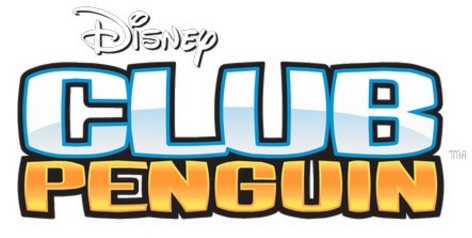
May 16, 2017
In the early hours of March 30th, the massively multiplayer online tyrant that once was, Club Penguin, shut down its servers permanently. Aimed at children through the ages of six through fourteen, it was designed as a safe hangout for its audience topped with a frigid frosting of color and childlike wonder. Initially starting as sequentially numbered versions of Penguin Chat, creator New Horizon Interactive (now Disney Canada) proposed their little experiment into stardom.
In the virtual world, players could socialize with other penguins, deck out their own with a variety of cartoonish wear, customize their personal igloo with whatever furniture fit suit, adopt adorably fluffy pets called “puffles,” and enjoy mini-games to earn precious virtual currency. At its zenith, the game was estimated to have over 250 million players–without a doubt of its success, the MMO caught the interest of the Walt Disney Company, purchasing the game in 2007 for 350 million dollars with an additional 350 million if specific targets were met.
For most Radnor students, Club Penguin was a memory that was looked fondly upon. Most have grown out of it, but it never hurt to take a trip back and get an enriching taste of nostalgia. Perhaps, you would also receive a bitter aftertaste of the cringey stuff the kid version of you did, but now both of these opportunities have been sullied. To Disney, Club Penguin was no longer profitable. The benefits of hosting the game were on decline, and so starting January 31st, Disney announced to the game’s population through a blog post that it was time to move on–or, as the in-game penguins would say it, “waddle on.”
The Waddle On Party was the last celebration that Club Penguin would ever hold, inviting current and former players to reminisce over the twelve years of frosty history. Parties were the game’s way of commemorating both real life and fictional events and holidays. Older players may recall their joyous times with the April Fools Party, or the Water Party (a personal favorite). Newer, younger players may have had the times of their lives with Disney-sponsored parties to promote recently released films, such as the Zootopia Party or the Finding Dory Party.
The party would last until the inevitable shutdown of Club Penguin. Young players all over the world came into the servers to say goodbye to their friends, their igloos, and their little puffball friends. But, behind the scenes, there was more going on. Older players only found brief entertainment in waddling around familiar locales, and giving the cheap Flash based mini-games one more go. They needed something more over the top and superfluous to satisfy their “mature” whims.
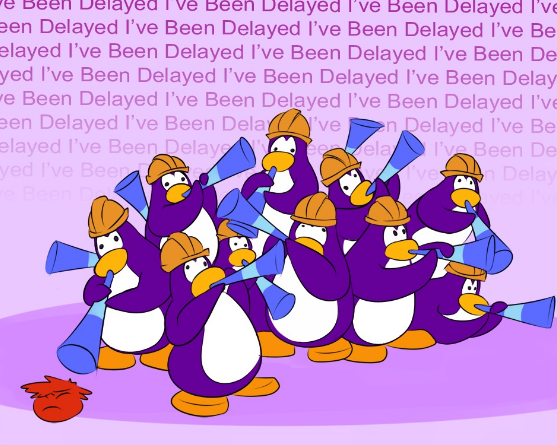
Enter the Purple Republic, henceforth abbreviated as PR, was a “[sic] well-organized, ruthlessly efficient, terrorist organization, supremacist institution and construction worker’s guild,” as the Club Penguin Fanon Wiki states. PR essentially was an assembly of older players who dyed their players purple, donned hard hats, played vuvuzelas, and drilled their hearts away, attempting to annoy and troll other players enough for them to leave. This was all working towards one global goal: “purple pride, server wide.”
Before Club Penguin’s announced shutdown, PR was occasionally active, rallying their efforts on websites like 4chan, plotting the next way to irritate the Club Penguin populace. They moved server to server, place to place, establishing dominance in their wake. Their job was performed not just by human players, but by controlled bots that obeyed their every command. These bots were most often utilized to create “the formation,” among other blockades.
Another niche group that misconstrued Club Penguin’s intended objective were perhaps as cunning as PR, but did not utilize this skill for sinful misdeeds. These were the speedrunners, the people interested in getting the fastest times possible within Club Penguin. But in what sort of category? Not in beating a mini-game in a short amount of time, or getting an arbitrary number of Coins. These skilled individuals craved a different sort of record: getting banned as quickly as they can.
Club Penguin was notorious for its methods of restricting speech. Players could only use words from a pool of words–a large one, but one that burdened the player enough that speaking to others could be occasionally difficult. Parents, if concerned about the words their child would hear online, could enable “Ultimate Safe Chat” mode, making it so that the only responses you could possibly utter were ones from a list of pre-made ones. If a penguin were to curse, they’d be given a warning. Do it again, and they’d be banned for a day. If they were to continue to disrupt the Club Penguin experience, bans could vary in length, from another day to permanently. Even words like “he’ll” could place you in danger of the banhammer.
Naturally, the community was interested in how fast a penguin could be punished. The rules for this were simple: have no tabs open, your clipboard emptied, and don’t use a penguin already created. Players turned on their timers and rushed to go through the registration process–inputting a random string of characters as their penguin’s name, going on a website to make a temporary email, and sprinting through all other registration processes, all to type in the F-word twice. The world record for this speedrun was 33 seconds, ran on the last day of the game’s availability, and the tool-assisted speedrun (using external software to play the game) was 29 seconds.
But, this fun could not last forever. These activities were all for a cause: to celebrate the memories the users had of Club Penguin. This whimsical phenomenon was a humble corner of the Internet for many, separate from the drama of social media, and a method of escapism from issues in the real world. Playing the games, experiencing wonderful parties, and meeting new friends brought a comfortable catharsis to all the players.
Time was ticking. In our time zone, penguins would have to stay up to 3:00 A.M. to witness to closure of Club Penguin. A sense of finality was in the air. Speedrunners were earning the last possible records, and the users were nervous for what was to come. Even PR, as strong-willed as they assert themselves to be, shared the same anxieties as everyone else.
2:59 A.M. The beach area outside the lighthouse is full of penguins. The majority of which were PR, drilling the snowbound land one more time. They voiced their feelings, sang songs, and waved their final goodbyes. Interestingly, one penguin says “see you tomorrow.”
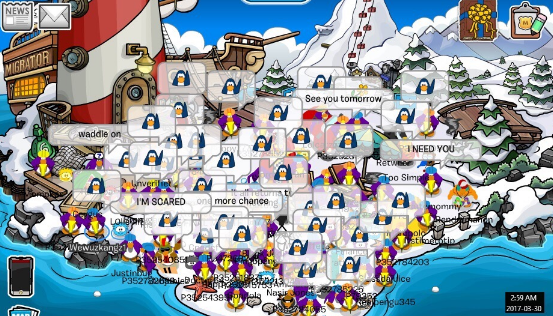
3:00 A.M. Penguins are awaiting their fate, but it seems the shutdown is delayed. Their goodbyes transition to hearts, expressing their love of the game. More penguins follow the lonely penguin, repeating “see you tomorrow” once more. They prepare for the end.
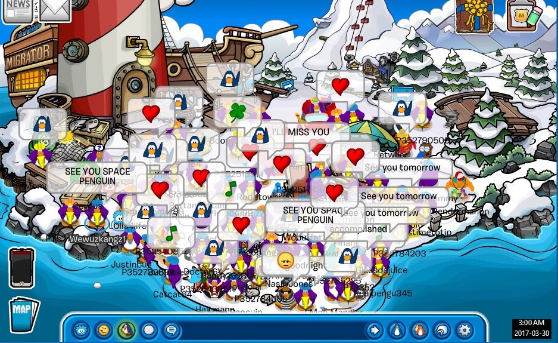
At 3:01 AM, everything goes silent.
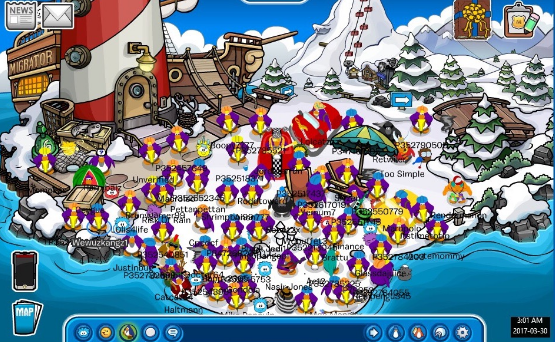
Finally, 3:02 A.M arrives. Players are met with a final message:
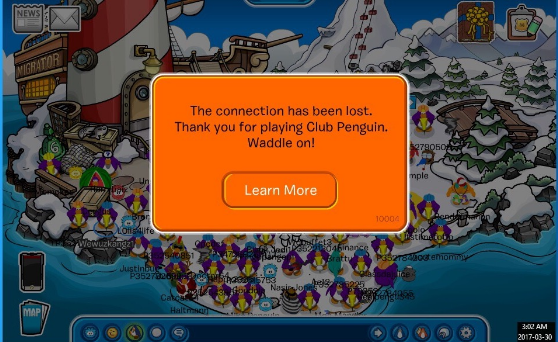
The last words, “waddle on,” were repeated constantly throughout the party. It was a brief phrase that represented a transition, a change. Disney Canada had planned a successor for Club Penguin. Children nowadays are attached to their mobile device, and to capitalize, Club Penguin Island was introduced, set to release around the same time Club Penguin was to shut down.
Last I checked, Club Penguin Island has two stars on the App Store, with a majority of ratings giving it only a single one. Judging by this, Club Penguin Island seems to have failed, in terms of generating the same atmosphere and childlike wonder its predecessor once possessed. “Waddle on,” to the ones dissatisfied with the sequel of Club Penguin, meant that a corner of the Internet was to vanish, and it was time to move onto better things.
Club Penguin, to me, was a prized artifact of the mid to late 2000s. In this day and age, social media dominates the Internet. In those times, the Internet was like a vast, mysterious world to surf and explore. But nowadays, it seems like the ones who use it only drift into the biggest corners, as the old ones decline in popularity. Club Penguin brought a well-needed silliness to the net, and now that it has faded, a piece of the Internet has died, giving headway to the social media bubble at large. Our lives on the net and our ones in the real life are starting to merge. It is something to observe as time goes on and the Internet continues to evolve.
One last note: a myth has existed since around the start of the game itself. If enough penguins are to drill the Iceberg, a location in Club Penguin, it would tip over, revealing some special surprise. This was only a fable, and there was nothing that would prove its existence. That was, until the Waddle On Party started.
Following the instructions of the myth, players drilled, encouraging others to do so, until the iceberg they stood on wobbled. It would grow in intensity over time, and eventually, it flipped over. The players did earn their surprise: a blue hard hat for their efforts, and a special message that stirs even the soul:
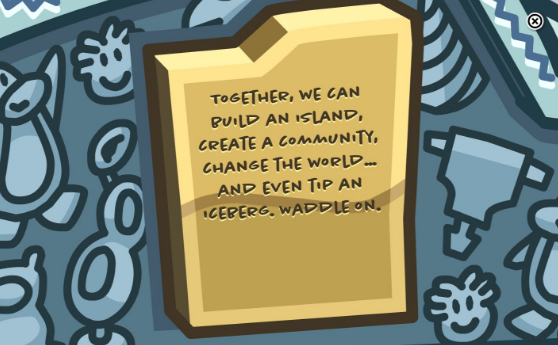
Waddle on,
James “Jake” Barone






